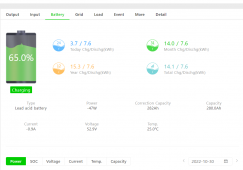As shown, the only way power can reach anything other than the battery is by flowing through wires toward house and grid.
Inverter has no way to know whether some of the power reaches grid.
Two ways to accomplish that:
1) Current Transformers around wires after house, before grid. Inverter monitors that, reduces output to stop export.
2) Load on some output terminals of inverter, grid on grid terminals. Inverter monitors internal current transformers, ensures no power flows out grid terminals.
If you have microinverters or other independent grid-tie inverters, SolArk inverter might open "Generator" relay to disconnect them so they can't backfeed to grid.
Hedges
You know way more about this stuff than I do... but my current setup is Grid Input to Grid Pins on Solark. Load to main home breaker from Solark. AC Coupled Input to Gen Pins... and 1 16cell 48V battery connected .
I have the Current Transformers installed to monitor the flow to and from the Grid and they are working as expected and designed.
My meter also has a small blinking arrow that points one way for power into home, and the other way for power exiting home.
I don't understand your statement 2 above Sorry...
Your last statement is correct, if/when the Sol-ark sees too much PV power from the AC coupled array , it will remove the 250V from the PV input Gen pins, and the Enphase inverters will turn off. It also has a method that looks at the battery % charge level that I can program, and when the batteries reach 100% charge, and the PV input is > the Load it turns off the AC coupled inverter, and starts using the battery for Load. Once the batteries get to a second programmed lower level the Solark senses this lower level, and re-enables the AC coupled Gen pins with 250V and the Enphase inverters turn back on to charge the battery back up, and support loads.
All this I have verified.. only remaining issue is even when it has batteries that need charge, and loads that need support it will begin sending power back to the grid.. and this is (I believe) a bug that Sol-ark is investigaing. I will share what I learn on that.
Thanks for the reply...
Per tech support at Sol-ark they indicate that if the Grid Sell option is unchecked that should prevent selling excess power not used to charge batteries or to support load to the grid. There is also a Grid Sell amount box that can be adjusted to increase or decrease the amount of power sent to the grid.... So they do monitor the AC coupled PV input and can turn it on and off as needed.
As of now since I don't want trouble with my local electric supplier I am just running the Kitchen oven when the PV produced is greater that the home Load, or battery charge need , and that prevents power from going back to grid. After my battery is back to 100%, I will just flip the main cut off switch on the side of the house.
All of this will become "uneeded" when my local electric supplier approves my PV interconnect agreement, so perhaps I just need to be patient and use the silly tricks to shed load, or disconnect from Grid as I am doing.







